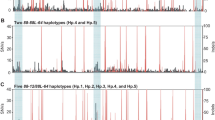Abstract
Multiple IgA subclasses have been identified in humans, primates and lagomorphs, whereas in mice, cattle and dogs only a single subclass has been identified. The two human subclasses (IgA1 and IgA2) are defined by a difference in the length of the hinge region of the α chains between the CH1 and CH2 domains. The single IgA subclass so far identified in dogs has an α-chain hinge region with a predicted amino-acid sequence similar to that of the human α1 chain. Allelic variants that differ in the coding sequence of the hinge region have been identified in mice and pigs. In order to investigate whether allelic variants are present in dogs, a portion of the IGHA gene from eight individual dogs was cloned and sequenced. Four sequence variants were identified, and these differed in the coding region of their hinge. A major difference between the variants was the presence of a base polymorphism in the splice acceptor site for the second exon, which resulted in shortening of the hinge in two of the variants. Individuals expressed one or two of the variants identified, suggesting they may be heterozygous or homozygous. Further work is required to determine the effect of the variation on the biological activity of dog IgA and any relationship to susceptibility to mucosal disease.



Similar content being viewed by others
References
Batt RM, Needham JR, Carter MW (1983) Bacterial overgrowth associated with a naturally occurring enteropathy in the German shepherd dog. Res Vet Sci 35:42–46
Batt RM, Barnes A, Rutgers HC, Carter SD (1991) Relative IgA deficiency and small intestinal bacterial overgrowth in German shepherd dogs. Res Vet Sci 50:106–111
Batten MR, Senior BW, Kilian M, Woof JM (2003) Amino acid sequence requirements in the hinge of human immunoglobulin A1 (IgA1) for cleavage by streptococcal IgA1 proteases. Infect Immun 71:1462–1469
Boehm MK, Woof JM, Kerr MA, Perkins SJ (1999) The Fab and Fc fragments of IgA1 exhibit a different arrangement from that in IgG: a study by X-ray and neutron solution scattering and homology modelling. J Mol Biol 286:1421–1447
Brown WR, Kacskovics I, Amendt BA, Blackmore NB, Rothschild M, Shinde R, Butler JE (1995) The hinge deletion allelic variant of porcine IgA results from a mutation at the splice acceptor site in the first C alpha intron. J Immunol 154:3836–3842
Chintalacharuvu KR, Chuang PD, Dragoman A, Fernandez CZ, Qiu J, Plaut AG, Trinh KR, Gala FA, Morrison SL (2003) Cleavage of the human immunoglobulin A1 (IgA1) hinge region by IgA1 proteases requires structures in the Fc region of IgA. Infect Immun 71:2563–2570
Flanagan JG, Lefranc MP, Rabbitts TH (1984) Mechanisms of divergence and convergence of the human immunoglobulin alpha 1 and alpha 2 constant region gene sequences. Cell 36:681–688
German AJ, Hall EJ, Day MJ (2000) Relative deficiency in IgA production by duodenal explants from German shepherd dogs with small intestinal disease. Vet Immunol Immunopathol 76:25–43
Hayden DW and Van Kruiningen HJ (1982) Lymphocytic-plasmacytic enteritis in German shepherd dogs. J Am Anim Hosp Assoc 18:89–96
Heddle RJ, Rowley D (1975) Dog immunoglobulins. I. immunochemical characterization of dog serum, parotid saliva, colostrum, milk and small bowel fluid. Immunology 29:185–195
Hoenig M (1980) Intestinal malabsorption attributed to bacterial overgrowth in a dog. J Am Vet Med Assoc 176:533–535
Lefranc M-P (2003) IMGT, the international ImMunoGeneTics database(R). Nucleic Acids Res 31:307–310
Lefranc M-P, Lefranc G (2001) The Immunoglobulin FactsBook. Academic Press, London
Mazanec MB, Nedrud JG, Kaetzel CS, Lamm ME (1993) A three-tiered view of the role of IgA in mucosal defense. Immunol Today 14:430–435
Mestecky J, Moro I, Underdown BJ (1999) Mucosal Immunoglobulins. In: Ogra PL, Mestecky J, Lamm ME, Strober W, Bienenstock J, McGhee JR (eds) Mucosal immunology. Academic Press, San Diego, pp 133–152
Navarro P, Christensen RK, Weber P, Rothschild M, Ekhardt G, Butler JE (2000) Porcine IgA allotypes are not equally transcribed or expressed in heterozygous swine. Mol Immunol 37:653–664
Patel M, Selinger D, Mark GE, Hickey GJ, Hollis GF (1995) Sequence of the dog immunoglobulin alpha and epsilon constant region genes. Immunogenetics 41:282–286
Peters IR, Helps CR, Batt RM, Day MJ, Hall EJ (2003) Quantitative real-time RT-PCR measurement of mRNA encoding alpha-chain, pIgR and J-chain from canine duodenal mucosa. J Immunol Methods 275:213–222
Phillips-Quagliata JM (2002) Mouse IgA allotypes have major differences in their hinge regions. Immunogenetics 53:1033–1038
Rozen S, Skaletzky HJ (2000) Primer3 on the WWW for general users and for biologist programmers. Humana Press, Totowa, N.J.
Rutgers HC, Batt RM, Elwood CM, Lamport A (1995) Small intestinal bacterial overgrowth in dogs with chronic intestinal disease. J Am Vet Med Assoc 206:187–193
Senior BW, Dunlop JI, Batten MR, Kilian M, Woof JM (2000) Cleavage of a recombinant human immunoglobulin A2 (IgA2)-IgA1 hybrid antibody by certain bacterial IgA1 proteases. Infect Immun 68:463–469
Willard MD, Simpson RB, Fossum TW, Cohen ND, Delles EK, Kolp DL, Carey DP, Reinhart GA (1994) Characterization of naturally developing small intestinal bacterial overgrowth in 16 German shepherd dogs. J Am Vet Med Assoc 204:1201–1206
Acknowledgements
The contribution of the clinical staff that cared for these patients is gratefully acknowledged. This study was funded by a grant from the WALTHAM Centre for Pet Nutrition.
Author information
Authors and Affiliations
Corresponding author
Additional information
Nucleotide sequence data reported are available in the DDBJ/EMBL/GenBank databases under the accession numbers AY576788–AY576795
Rights and permissions
About this article
Cite this article
Peters, I.R., Helps, C.R., Calvert, E.L. et al. Identification of four allelic variants of the dog IGHA gene. Immunogenetics 56, 254–260 (2004). https://doi.org/10.1007/s00251-004-0686-x
Received:
Revised:
Published:
Issue Date:
DOI: https://doi.org/10.1007/s00251-004-0686-x




